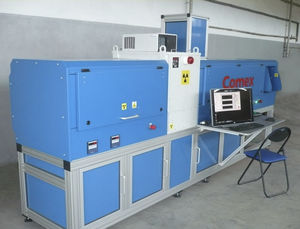
- Products
- Catalogs
- News & Trends
- Exhibitions
Sorting machine for the chemical industry CXR series for the mining industryX-rayautomatic

Add to favorites
Compare this product
Characteristics
- Application domain
- for the chemical industry, for the mining industry
- Type
- X-ray
- Operational mode
- automatic
- Product applications
- parts, for mineral material, coal powder
- Throughput
Max.: 250 p/h
Min.: 15 p/h
Description
Feed material is supplied to the vibrating chute, where individual rocks are separated before falling on to the horizontal belt. The rocks are supplied to the X-ray analyzing unit and at the end of the belt they enter the optical analyzer zone. In this area, different optical properties of the particles are analyzed and registered.
Images are taken by the optical camera (line scan camera ) and the X-ray analyzer under dynamic conditions. The system is operated by the control system based on an industrial PC employing a separation algorithm based on selected separation criteria. Each particle can be identified in terms of it’s dimensions, shape and structure, and its position on the conveyor is registered for possible further rejection.
Results from image processing can be displayed as a number of different parameters describing the material properties. In addition to material colour and internal structure, there are over 50 parameters (such as diameter, perimeter, centre of mass, moment of inertia, particle orientation, elongation factor etc.) normally used for particle shape identification. Additional combinations of these parameters can also be used for distinguishing particles of interest. Each particle has a specified position and size so it is possible to use the rejecting mechanism (air nozzles) to separate them from the material stream.
VIDEO
Catalogs
Comex Test Centre
10 Pages
*Prices are pre-tax. They exclude delivery charges and customs duties and do not include additional charges for installation or activation options. Prices are indicative only and may vary by country, with changes to the cost of raw materials and exchange rates.






